Bergamot 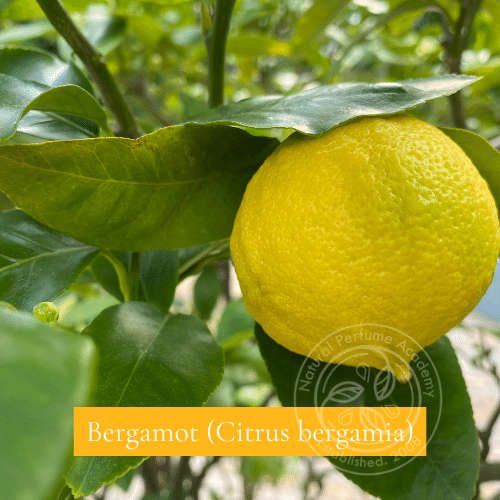
Title: Bergamot (Citrus bergamia)Description:
Bergamot, scientifically known as Citrus bergamia, is a citrus fruit prized in perfumery for its distinctive aroma and versatile applications. The essential oil of bergamot is extracted from the fruit's peel through a cold-pressing method, capturing its vibrant scent profile and therapeutic properties. Characteristics: - Aroma: Bergamot oil is renowned for its fresh, citrusy fragrance, characterized by bright, uplifting notes with a delicate floral undertone.
- Color: The oil typically exhibits a pale greenish-yellow hue, reflecting the color of the bergamot fruit peel.
- Consistency: Bergamot oil possesses a thin, watery consistency, making it easy to blend with other essential oils and carrier oils.
- Chemical Composition: The volatile compounds present in bergamot oil include limonene, linalyl acetate, and bergapten (a psoralen compound responsible for photosensitivity).
Variants: - Standard Bergamot Oil: Traditional bergamot oil contains natural levels of bergapten, a photosensitizing compound that can cause skin pigmentation and increased sensitivity to sunlight. While prized for its aroma, bergapten poses risks when applied to the skin before sun exposure.
- Bergapten-Free Bergamot Oil: In response to safety concerns, bergamot oil variants with reduced or eliminated levels of bergapten have been developed. These "bergapten-free" or "FCF" (furanocoumarin-free) bergamot oils offer the same aromatic profile without the associated photosensitizing effects, making them safer for topical use.
Usage in Perfumery: - Top Note: Bergamot oil is often used as a top note in perfume compositions, contributing its bright, citrusy aroma to blends.
- Blending: Its versatile nature allows bergamot oil to harmonize with a wide range of other essential oils, including floral, woody, and herbal notes.
- Freshness: Bergamot's refreshing scent adds a vibrant, invigorating quality to fragrances, making it a popular choice for citrus-based and unisex perfumes.
- Aromatherapy: Beyond perfumery, bergamot oil is valued in aromatherapy for its mood-enhancing and stress-relieving properties, promoting relaxation and emotional balance.
Safety Considerations: - Photosensitivity: Standard bergamot oil containing bergapten can cause skin sensitivity and pigmentation when exposed to sunlight. It is recommended to avoid applying bergamot oil to the skin before sun exposure.
- Patch Testing: Prior to topical application, it is advisable to perform a patch test to assess individual sensitivity to bergamot oil, especially in formulations containing bergapten.
References: - Essential oil analysis and safety guidelines based on industry standards and scientific literature.
- Research on bergamot oil variants and their applications in perfumery and aromatherapy.
|
|
Bitter orange 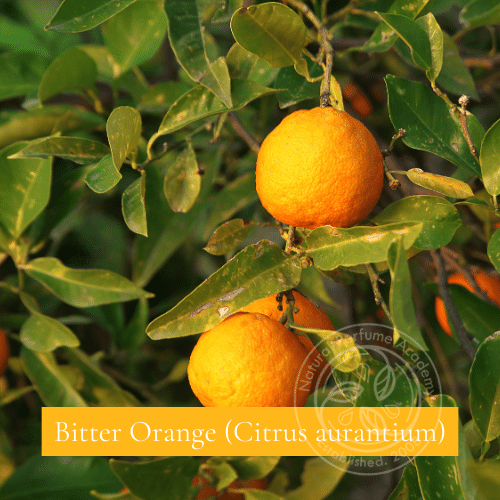
Title: Bitter Orange (Citrus aurantium)Description:
Bitter orange, scientifically known as Citrus aurantium, is a citrus fruit prized for its aromatic peel and diverse applications in perfumery, culinary arts, and traditional medicine. Unlike sweet orange varieties, bitter orange is characterized by its distinctly tart flavor and aromatic zest. Characteristics: - Fruit: Bitter orange fruit resembles its sweet counterpart in appearance, with a rough, textured peel that ranges from yellow-orange to deep orange hues.
- Aroma: The essential oil extracted from bitter orange peel exhibits a complex aroma, blending citrusy, floral, and slightly bitter notes with a refreshing zestiness.
- Color: Bitter orange essential oil typically possesses a pale to golden yellow color, reflecting the hue of the fruit's peel.
- Consistency: The oil has a thin, watery consistency, allowing for easy blending with other essential oils and carriers.
Chemical Composition: - Bitter orange essential oil contains various volatile compounds, including limonene, linalool, and citral, which contribute to its distinctive fragrance and therapeutic properties.
Usage in Perfumery: - Top Note: Bitter orange oil is commonly used as a top note in perfume formulations, imparting its vibrant, citrusy aroma to blends.
- Versatility: Its versatile nature allows it to complement a wide range of fragrance families, including citrus, floral, oriental, and woody compositions.
- Freshness: Bitter orange adds a bright, refreshing quality to perfumes, enhancing their overall freshness and vitality.
- Blending: It harmonizes well with other citrus oils, floral absolutes, spice oils, and woody essences, offering perfumers endless creative possibilities.
Culinary and Medicinal Uses: - Bitter orange peel is used in culinary applications to flavor foods and beverages, imparting a tangy, citrusy taste to dishes, marmalades, and liqueurs.
- In traditional medicine, bitter orange extracts are valued for their digestive, anti-inflammatory, and appetite-stimulating properties, often used in herbal remedies and dietary supplements.
Safety Considerations: - Bitter orange essential oil is generally considered safe for topical use when properly diluted; however, it may cause skin sensitivity in some individuals, particularly when applied undiluted or in high concentrations.
- As with all essential oils, it is recommended to perform a patch test before widespread use to assess individual sensitivity.
References: - Essential oil analysis and safety guidelines based on industry standards and scientific literature.
- Research on the aromatic profile, chemical composition, and therapeutic properties of bitter orange essential oil.
|
|
Body 
Title: BodyDefinition:
In perfumery, "body" refers to the underlying strength, fullness, and substance of a fragrance composition. It denotes the robustness and persistence of the scent on the skin or in the air, contributing to the overall richness and depth of the olfactory experience. Characteristics: - Strength: Body in a fragrance indicates its intensity and potency, with stronger-bodied scents possessing a more pronounced and enduring presence.
- Fullness: Fragrances with body exhibit a satisfying fullness and roundness in their aroma profile, lacking any sense of thinness or insubstantiality.
- Persistence: The body of a fragrance influences its longevity, with scents characterized by a strong body typically lasting longer on the skin and retaining their olfactory impact over time.
Factors Influencing Body: - Concentration: The concentration of aromatic ingredients in a fragrance formulation directly impacts its body, with higher concentrations resulting in greater richness and depth.
- Ingredients: Certain fragrance ingredients, such as resins, woods, and base notes, contribute to the body of a scent by imparting depth, warmth, and longevity to the composition.
- Blending Technique: Skillful blending techniques, including layering, maceration, and aging, can enhance the body of a fragrance by allowing its components to meld and harmonize over time, resulting in a more cohesive and robust olfactory profile.
Importance of Body: - Body is a crucial aspect of fragrance quality, influencing the overall sensory experience and perceived value of a scent. Fragrances with body are often perceived as more luxurious, sophisticated, and enduring, appealing to discerning consumers seeking high-quality olfactory experiences.
Usage in Perfumery: - Perfumers and fragrance enthusiasts use the term "body" to describe the substantive and enduring nature of a scent, evaluating its strength, depth, and persistence as key indicators of fragrance quality and character.
Examples: - Fragrances with a strong body, such as rich oriental blends or deep woody compositions, are favored for their ability to leave a lasting impression and evoke a sense of elegance and sophistication.
- Perfumers often employ ingredients known for their body-enhancing properties, such as amber, patchouli, and oud, to create fragrances with depth and substance.
Significance: - Understanding and enhancing the body of a fragrance is essential for perfumers seeking to create captivating and memorable scents that resonate with consumers and stand out in a competitive market.
|
|
Boronia
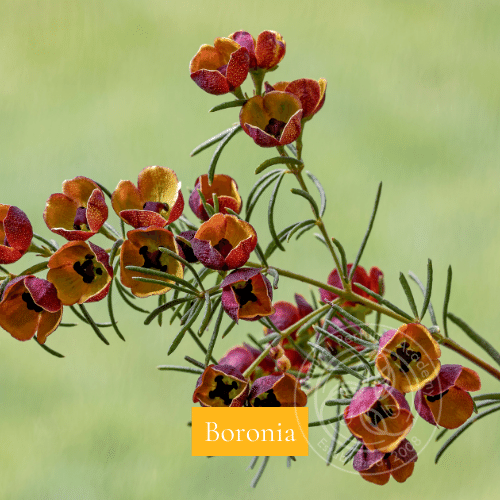
Title: BoroniaDescription:
Boronia, known for its captivating fragrance and distinctive brown cup-shaped flowers, is a genus of flowering plants native to Australia. With approximately 95 species, Boronia encompasses a variety of aromatic plants prized for their intense perfume and ornamental value. Species and Fragrance: - Boronia Megastigma: Among the species, Boronia megastigma stands out for its exceptionally fragrant blooms, which are highly valued in flower arrangements and perfumery. The flowers, characterized by their brown hue and yellow interiors, exude a potent and alluring aroma that adds depth and complexity to fragrant compositions.
Extraction Process: - In perfumery, Boronia flowers are meticulously harvested and subjected to solvent extraction to obtain a concentrated aromatic material known as Boronia concrete. This concrete undergoes further extraction with alcohol to yield Boronia absolute, a prized aromatic ingredient cherished for its exquisite scent and versatility in perfumery.
Characteristics of Boronia Absolute: - Appearance: Boronia absolute typically presents as a semi-liquid substance with a dark green hue, reflecting the rich botanical compounds extracted from the flowers.
- Aroma: The absolute emanates a fruity and tea-like fragrance with floral undertones, evoking sensations of warmth, sweetness, and sophistication.
- Versatility: Renowned for its complex and multifaceted aroma, Boronia absolute finds widespread application in natural perfumery, where it harmonizes beautifully with various floral, fruity, and woody notes.
Usage in Perfumery: - Base Formulations: Boronia absolute serves as a valuable ingredient in base formulations, lending depth, richness, and a naturalistic quality to perfumes.
- Pairing: It complements and enhances the olfactory profile of fragrances featuring mimosa, violet, and honeysuckle, creating captivating scent combinations with nuanced floral nuances.
Cultural Significance: - Boronia holds cultural significance in Australia, where it is admired for its aesthetic appeal and aromatic allure, often featured in bouquets, floral displays, and botanical gardens.
References: - Botanical literature on Boronia species, emphasizing their fragrance, morphology, and cultivation.
- Perfumery textbooks and industry publications detailing the extraction process and olfactory characteristics of Boronia absolute.
- Insights from experienced perfumers and fragrance enthusiasts regarding the versatile applications of Boronia in perfumery formulations.
|
|
Bottom Notes 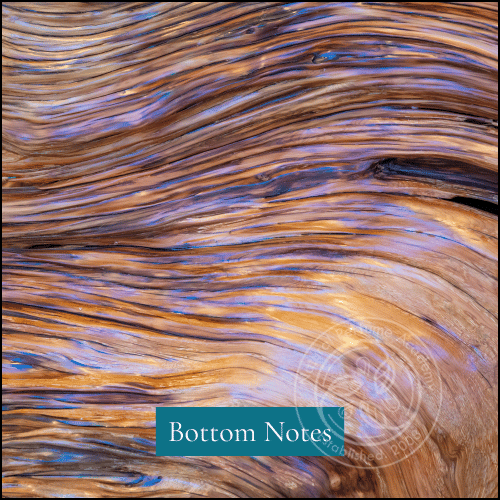
Title: Bottom Notes
Definition:
In perfumery, "bottom notes" refer to the foundational elements of a fragrance composition that emerge gradually during the dry-down phase and persist the longest on the skin. Also known as base notes, they form the enduring and lingering essence of a scent, providing depth, richness, and stability to the overall olfactory profile. Characteristics: - Tenacity: Bottom notes are characterized by their resilience and longevity, lingering on the skin for hours or even days after the application of a fragrance.
- Depth: These notes contribute to the depth and complexity of a scent, anchoring the composition with their rich and substantive aroma.
- Warmth: Bottom notes often exude warm, comforting, and enveloping qualities, adding a sense of depth and sensuality to the fragrance experience.
Role in Perfumery: - Structural Foundation: Bottom notes serve as the structural foundation of a fragrance, providing stability and coherence to the overall composition. They anchor the lighter top and middle notes, ensuring a harmonious and well-balanced olfactory experience.
- Longevity: Due to their tenacious nature, bottom notes play a crucial role in determining the longevity and persistence of a fragrance, extending its wear time and enhancing its overall impact.
- Emotional Resonance: The deep, resonant qualities of bottom notes evoke feelings of warmth, comfort, and intimacy, creating a lasting emotional connection with the wearer.
Examples of Bottom Notes: - Rich Woods: Ingredients such as sandalwood, cedarwood, and vetiver are classic bottom notes prized for their depth, warmth, and longevity.
- Resinous Accords: Resins such as benzoin, myrrh, and labdanum impart a deep, balsamic quality to fragrances, enhancing their longevity and complexity.
- Animalic Notes: Animalic ingredients like musk and ambergris add a sensual, musky undertone to fragrances, contributing to their depth and allure.
Usage in Perfumery: - Perfumers carefully select and blend bottom notes to create fragrances with enduring appeal and longevity. These notes are often added in higher concentrations to ensure their prominent presence in the dry-down phase.
- Consumers appreciate bottom notes for their ability to evoke a sense of luxury, sophistication, and comfort, making them sought-after ingredients in fine fragrances and perfumes.
Significance: - Understanding the role of bottom notes is essential for perfumers seeking to create well-balanced and long-lasting fragrances that resonate with consumers. By mastering the art of layering and blending bottom notes, perfumers can craft memorable scents that leave a lasting impression.
|
|
Bouquet

Title: BouquetDefinition: In perfumery, a bouquet refers to a harmonious blend of flower essences, traditionally used to create rich and complex floral compositions. Historical Context: The term is often associated with pre-modern perfumery, where natural botanical extracts were the primary ingredients in crafting luxurious scents. Characteristics: A bouquet composition is marked by the intricate layering of multiple floral notes, each contributing its unique aroma. Common flowers used include rose, jasmine, and violet. Usage in Natural Perfumery: Bouquets are prized for their depth and complexity. They serve as the foundation for many traditional and contemporary natural perfumes, highlighting the beauty and richness of floral extracts. Examples: Classic examples of bouquet compositions often evoke images of lush, blooming gardens and are used to create perfumes that are both elegant and sophisticated.
|
|
Calamus 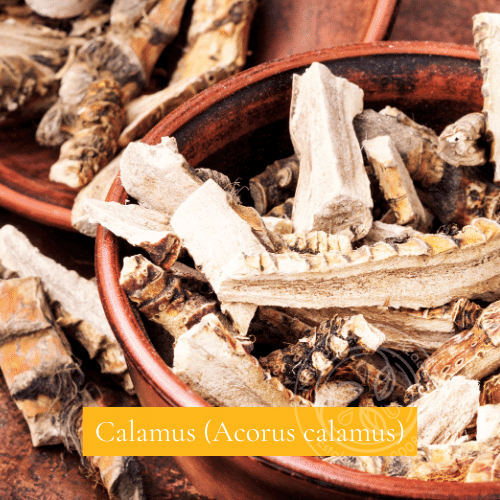
Title: Calamus (Acorus calamus)Definition: Calamus, also known as sweet flag, is a reed-like plant from which the essential oil is extracted. The botanical name is Acorus calamus. Extraction: The essential oil of calamus is typically obtained through steam distillation of the dried roots (rhizomes) of the plant. Characteristics: - Odor Profile: The oil has a warm, spicy, and slightly woody aroma, often described as a blend of cinnamon, ginger, and nutmeg with a hint of a leathery undertone.
- Appearance: The oil is usually pale yellow to light brown in color.
- Consistency: It has a medium to thick consistency.
Historical Context: Calamus has been used for centuries in traditional medicine, perfumery, and incense. It was highly valued in ancient cultures for its aromatic and therapeutic properties. Uses in Natural Perfumery: - Fixative: Calamus oil is often used as a fixative in perfumery to stabilize and enhance the longevity of more volatile fragrances.
- Blending: It blends well with other spicy, woody, and oriental notes, as well as with florals like rose and jasmine. It adds depth and warmth to perfume compositions.
- Types of Perfumes: Calamus is commonly found in oriental, spicy, and chypre perfumes.
Safety Considerations: Some varieties of calamus oil contain high levels of beta-asarone, which can be toxic. Therefore, it is important to ensure the oil used is safe and free from harmful levels of this compound. References: - Steffen Arctander: Perfume and Flavor Materials of Natural Origin.
|
|
Camphoraceous 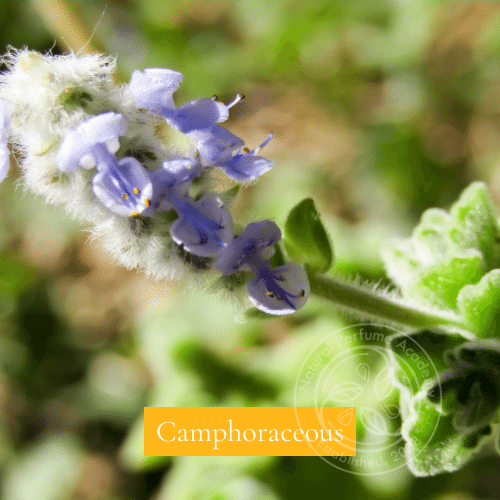
Title: CamphoraceousDefinition: The term "camphoraceous" refers to essences that have a camphor-like aroma. These scents are often described as sharp, fresh, and medicinal. Characteristics: - Odor Profile: Camphoraceous notes are characterized by a strong, penetrating, and cooling scent that is similar to that of camphor. This scent can evoke a sense of cleanliness and has a slightly medicinal quality.
- Common Camphoraceous Oils:
- Eucalyptus: Known for its fresh, clean, and somewhat sweet camphor-like aroma.
- Tea Tree: Offers a strong, medicinal, and herbaceous camphoraceous scent.
- Lavender: Contains subtle camphoraceous undertones that add to its fresh, herbal, and slightly sweet aroma.
- Rosemary: Features a robust, herbaceous scent with prominent camphoraceous notes.
Uses in Natural Perfumery: - Blending: Camphoraceous notes are often used to add freshness and a clean quality to perfumes. They can uplift and invigorate a composition, making them suitable for creating vibrant and energizing fragrances.
- Types of Perfumes: These notes are commonly found in herbal, medicinal, and fresh fragrances. They are also used in aromatherapy blends for their invigorating and clarifying properties.
Examples of Use: - Eucalyptus and Tea Tree: Often used in compositions that aim to create a sense of freshness and purity. These oils can also impart a slightly medicinal character to a blend.
- Lavender and Rosemary: Used in formulations to add depth and complexity. The camphoraceous undertones enhance the overall freshness of the scent.
References: - Steffen Arctander: Perfume and Flavor Materials of Natural Origin.
|
|
Carnation 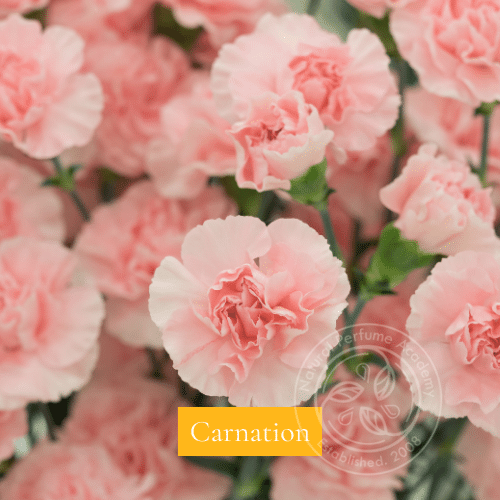
Title: Carnation AbsoluteBotanical Name: Dianthus caryophyllus Production Method: Carnation absolute is produced by an unusual method of alcohol washing of the concrete, which is obtained through the solvent extraction of the flowers. While the flowers are grown in many European countries and the United States, the concrete is exclusively made in France. Yield and Cost: The yield from the concrete is low, making it an expensive oil. Due to its high cost, carnation absolute is frequently adulterated. Characteristics: - Appearance: Olive green to green or orange-brown, viscous liquid.
- Odor Profile: Initially, the fragrance of carnation absolute does not immediately remind one of carnations, presenting a more herbal scent. However, after a few moments, the fragrance of freshly cut carnation flowers emerges, which is sweet and heavy. It has a very sweet, honey-like, somewhat herbaceous, heavy, and tenacious fragrance. In high dilutions (5% or weaker), it more closely resembles the scent of live flowers.
Uses in Natural Perfumery: - Blending: Carnation absolute pairs exceptionally well with clove, creating a harmonious and complementary note. This combination enhances the sweet and spicy profile in perfume compositions.
- Perfume Types: Often used in floral and oriental compositions, carnation absolute adds depth, sweetness, and complexity to the blend. It is valued for its ability to provide a rich, honeyed, and herbaceous nuance to perfumes.
Aromatic Notes: - Top Note: Herbal
- Middle Note: Sweet, floral (carnation-like)
- Base Note: Honey-like, heavy, tenacious
Country of Origin: The flowers are grown in various European countries and the United States, with concrete production primarily in France. Historical and Traditional Uses: Carnation has been valued for its distinctive fragrance and is a classic ingredient in many traditional perfumes. It has a long history of use in European perfumery and continues to be a treasured component in natural perfumery. References: - Steffen Arctander: "Carnation is an olive green to green or orange-brown, viscous liquid of very sweet, honey-like, somewhat herbaceous, heavy, and tenacious fragrance, reminiscent of the scent of the live flowers only to a certain degree and only in high dilutions (5% or weaker)." (Perfume and Flavor Materials of Natural Origin, p.128)
|
|
Carrier Oil 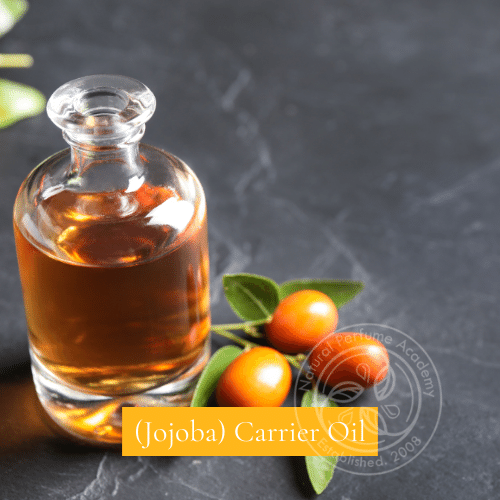
Title: Carrier OilDefinition: Carrier oils are base oils used to dilute essential oils and absolutes before they are applied to the skin. They are also used as a base in oil-based and solid perfume making. Common Types: - Jojoba Oil: Highly stable with a long shelf life. It is technically a liquid wax and is known for its moisturizing properties and similarity to the skin's natural sebum.
- Fractionated Coconut Oil: A highly stable oil that remains liquid at room temperature. It is light, non-greasy, and has an extended shelf life due to the removal of long-chain triglycerides.
Characteristics: - Jojoba Oil:
- Appearance: Clear to golden yellow liquid.
- Odor: Virtually odorless, making it an excellent carrier that does not interfere with the fragrance of essential oils.
- Properties: Moisturizing, non-greasy, long shelf life, and absorbs well into the skin.
- Fractionated Coconut Oil:
- Appearance: Clear, thin, and colorless liquid.
- Odor: Odorless, which makes it a neutral carrier that doesn’t alter the scent of the essential oils it carries.
- Properties: Lightweight, non-greasy, highly stable, and easily absorbed by the skin.
Uses in Natural Perfumery: - Dilution: Carrier oils are used to dilute essential oils to make them safe for topical application, reducing the risk of skin irritation.
- Base for Perfume: They serve as the base for oil-based perfumes, helping to carry and preserve the fragrance of essential oils and absolutes.
- Solid Perfumes: Used as a base ingredient in solid perfumes, combined with waxes and other ingredients to create a solid form.
Benefits: - Shelf Life: Both jojoba and fractionated coconut oils have long shelf lives, making them ideal for natural perfumery where stability and longevity are important.
- Skin Compatibility: These carrier oils are generally well-tolerated by most skin types and provide additional skin benefits such as moisturization and nourishment.
- Neutral Scent: Their lack of strong odor ensures that the true essence of the essential oils and absolutes can shine through without alteration.
Blending Suggestions: - With Essential Oils: Carrier oils can be blended with a variety of essential oils to create customized perfumes and therapeutic blends.
- For Solid Perfumes: Combine with beeswax or plant-based waxes to create solid perfumes that can be easily applied.
Additional Notes: While jojoba and fractionated coconut oils are commonly used due to their superior properties, other carrier oils such as sweet almond, grapeseed, and apricot kernel oil can also be used depending on the desired texture, scent, and skin benefits.
|
|












